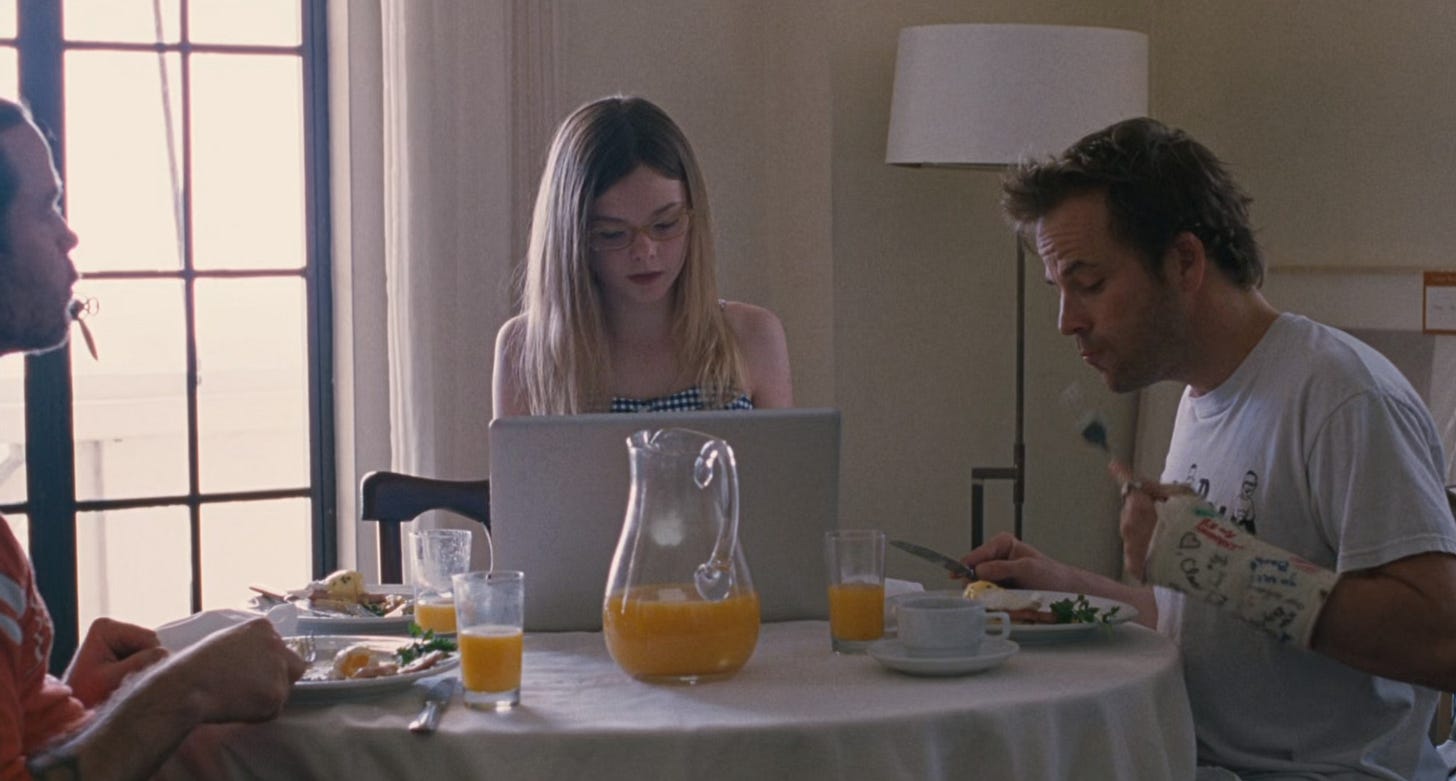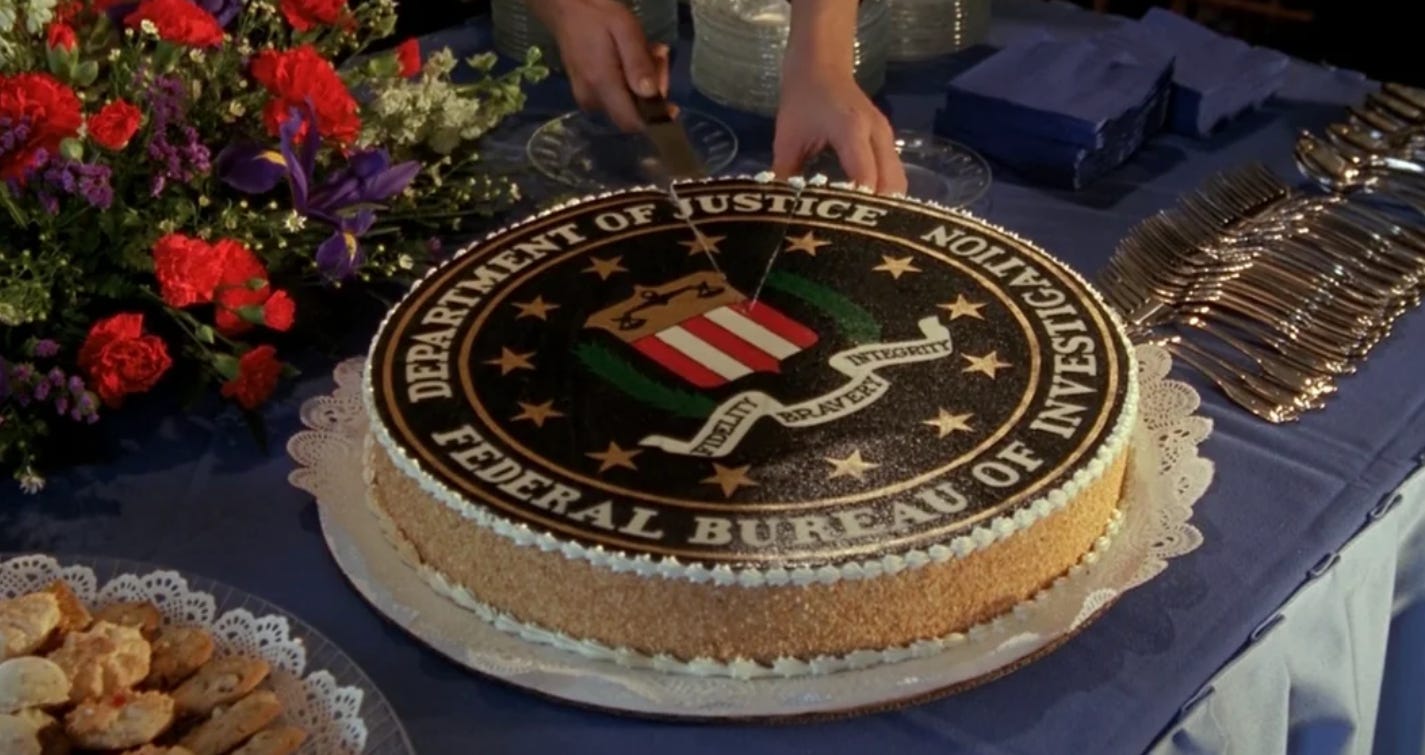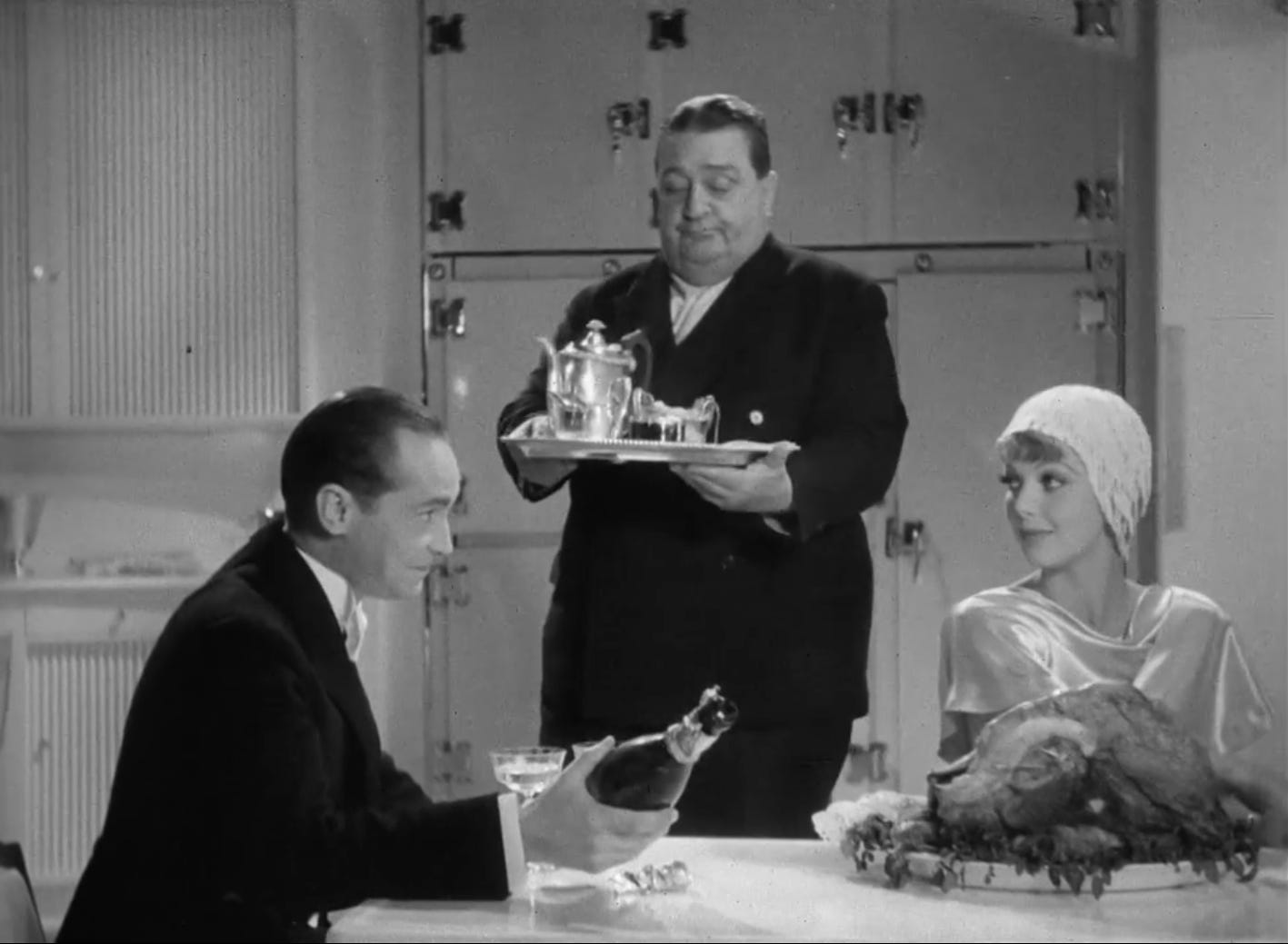12 writers on 12 meals in 12 different movies
A collaboration with GUTS MAGAZINE ft. Dwight Garner, Natasha Pickowicz, Jason Diamond, Alicia Kennedy, and more.
I don’t know what my favorite food scene is in a movie. What I can recount is the first time I started to notice these cinematic depictions of consumption. It was in 2010 while watching Sofia Coppola’s Somewhere. Elle Fanning is staying with her father, an actor, played by Stephen Dorff at the Chateau Marmont, his habitual haunt. It is morning and he’s hungover, I think. Fanning, her character is about 12-years-old, calls the front desk—not for room service, but to request supplies for breakfast so that she can make eggs benedict.
It’s not the dish that strikes me, but the insouciance of the scene and the act itself. As someone who don’t typically eat in the morning, the meal is an indulgence. That such a moment exists in a Sofia Coppola film is both notable and fitting. Here eating breakfast isn’t care, so much as it is self-care (even though, yes, Dorff’s lifestyle usually precludes maternal; and yes, breakfast can and is nourishing in other contexts), showing us the beginnings of how food can embody what we now think of as lifestyle.
I won’t go on much longer since that’s kind of what I do every month here at moviepudding.
Instead I'm handing the reins over to my friend , a writer from Oakland and currently living in Ljubljana, Slovenia. His offal and hospitality-focused newsletter GUTS MAGAZINE strikes the perfect balance of dark humor and sincerity and his appetite for movies and restaurants rivals, perhaps even surpasses, my own. (You’ll be hearing more about him in this newsletter soon).
Together, we rounded up some of our favorite writers to discuss their favorite scenes in movies, mostly about anything but.
GUTS MAGAZINE
I started clocking food in movies because of my parents. My mom is a certified gourmet, and the movie I remember her loving the most, besides Die Hard (1988), is Babette’s Feast (1987). One of my father’s favorites is Fanny & Alexander (1982), the version that includes the dinner scene, of course. We all love Big Night (1996) and one New Years Eve, we booked a timpano themed dinner at our favorite Italian spot, Dopo (R.I.P.) in Oakland. Food and movies often brought us together, which probably facilitated my obsession with both.
Nowadays I point at the screen when I see an actor eat, so it’s been a great joy compiling this list with Elissa and the other writers featured here. There are so many great food scenes to choose from, and I hate to be that guy picking Tarantino, but Brad Pitt making kraft macaroni and cheese in Once Upon a Time In Hollywood (2019) has to be my favorite in a recent film. Actually, maybe the ortolan scene from the Taste of Things (2023) takes that crown, but this one has stuck with me longer. It’s a scene so short you can blink and miss it, but that also means you can run it back repeatedly like I have.
Cliff Booth, played by Pitt, is not a good guy. He murdered his fucking wife, for godsake. That may only be alluded to in Tarantino’s latest, maybe final film, but if you read the tie-in novel it’s spelled out: “Cliff Booth shoots his wife with a harpoon gun on a boat, and holds her body as she slowly splits in two.” You can argue that what matters is up on the screen, but the movie certainly doesn’t. It’s steeped in Hollywood mythology; the murder rumors are an allusion to Natalie Wood, who mysteriously drowned during a boat trip with her husband Robert Wagner. Tarantino is no stranger to subtext, and if, like Scorsese said, “cinema is a matter of what’s in the frame and what’s out” then all of this, everything, the myths, the rumors, the film, and the tie-in novel definitely matter.
Boxed macaroni and cheese definitely matters.
Why exactly is it so riveting to watch Brad Pitt make kraft dinner in his live-in trailer behind a drive-in movie theatre? The scene, like Hunter Harris wrote in 2019, is erotic. I think of it often. Pitt carelessly pours water out of the saucepan, tosses in powdered cheese, mixes it together in a few quick jump cuts, then sits down to eat right out of the pot. While he cooks, a cigarette is flicked onto dirty dishes, the TV plays loudly in the background, and the camera moves slowly around the trailer, highlighting comic books and other pop culture memorabilia I do not fully understand. There is a comforting pleasure in all this that echoes the comfort of his meal. The world is being built around that comfort, a little depth is added to Cliff Booth’s character, and a little sympathy is too. Here is a man who charmingly, handsomely, humbly makes himself kraft dinner while also feeding his adorable dog named Brandy, in a sloppy, messy, cramped space. Who hasn’t lived with a kitchen in that kind of disarray? There’s a great feat of relatability going on in this scene. A reminder that stars are people and that we can be stars too. Either Brad Pitt is slumming it, or we all have the potential to be drop dead gorgeous with a dirty kitchen, a cute dog, and a proximity to glamour.
The thing is, we don’t know these people. Just like Cliff Booth is not a good guy, Brad Pitt, in all likelihood, is also not a good guy. Stardom, Hollywood, movies, thrive on that suspension of disbelief, a willful ignorance to reality. These days it's a lot harder to maintain, in the 60’s when Once Upon a Time in Hollywood is set, the facade was easily bought into. That’s one of the reasons I love food scenes in movies. Everybody has to eat. Even if it’s stylized, the act of consumption grounds people. Brad Pitt as Cliff Booth making macaroni and cheese is the perfect example. A movie star is not a person, unless they’re making kraft dinner, then they’re just like me for real.
Here are some of our favorite writers on their favorite scenes…
Writer, author of No Meat Required: The Cultural History and Culinary Future of Plant-Based Eating and the inimitable From the Desk of Alicia Kennedy.
There’s a scene in Before Night Falls (2000)—a Julian Schnabel movie about the Cuban writer Reinaldo Arenas starring Javier Bardem—where Reinaldo is working on edits to his manuscript on a Havana rooftop while eating boiled broccoli and eggs. I loved this scene when I was young because I wanted to be a writer sweating on a Caribbean rooftop, too absorbed in my work for a proper meal. I didn’t know though, when I first saw it, how accurate it was to working on a book: I have no appetite when I’m inside a manuscript. Broccoli and eggs, simply boiled, make perfect sense.
Natasha Pickowicz
James Beard-award winning pastry chef, author of More Than Cake, which taught me how to stop worrying and love baking cake.
I'm obsessed with spotting cakes in films. (Wedding cakes don't count; that's too easy and obvious.) Even better if the cake is only in frame for a matter of seconds, coming and going so fast that you'd miss it if you weren't looking for it specifically. I have a folder in my phone just for blurry photos taken to commemorate these liminal sugar moments. I'd like to talk to the bakers who have made these cakes for various films over the years, if they made multiple cakes for multiple takes, if they used their own recipes to make the frosting and the insides, if the crew ate it afterward. I'm absolutely in love with the massive FBI cake at the end of Silence of the Lambs (1991): its scale and proportions, the doily hanging out, the tidy piping trim and the crumb-coated sides, and most of all, the sleek FBI logo sugar paper-transferred onto the surface. The way the server cuts the first slice (a wedge, as you would from a standard pie) has always driven me nuts. Given the scale of the cake, every subsequent slice is going to look like shit. But in the film, it doesn't matter. It is perfect.
Chef and writer from Dublin who has cooked in kitchens all over Europe such as Antiga Camponesa, Casa Lhasa, Bar Martin, Bar Principal, Bar Brutal, Trattoria Gloria, and Bar La Sang among others. Catch him on Gareth’s Substack.
1990. I was ten years old and often wanted to be alone. Macaulay Culkin as Kevin McCallister in Home Alone sits in front of the tv eating ice cream, a big packet of crisps next to him and a can of Pepsi. I saw myself in that movie. When my mum went shopping I stayed at home to do my homework, which I didn’t do until I was on the bus the next morning. Instead I watched movies and ate ice cream or crisps or cereal. When I stayed at my dad’s in Dublin I woke up early and watched cable tv and ate Tortilla Chips and drank Coca Cola. Kevin wishes his family would disappear. I didn’t want that to happen, I only wanted to eat junk and watch rubbish.
Writer you’ve likely read in GQ, Esquire, NYMag, and author Searching for John Hughes, among others. He also publishes The Melt newsletter.
I've always wondered what it says about me that I often crave a sardine on top of a pretzel, and that the only reason I even think of that combination is because of 1989's The ‘Burbs. The snack is supposed to be a gag, something creepy Hans Klopek offers Tom Hanks and his fellow snooping neighbors the way somebody might put out brie or cocktail wieners. Yet ever since I first saw the movie when I was 8 or 9 I've hought, damn, that sounds really nice right now. I've even thought about offering it to guests who come to my own home the same way Hans does it, and wondering who'd get the reference, who'd be disgusted, and who would rip a sardine and pretzel without a second thought.
Writer and author of the newsletter Female Small Business Owner and the forthcoming novel Herculine. One of the few people who excels in fiction, memoir, and criticism(!) alike.
A lack of food can be a pornographic aesthetic. When I first watched Todd Haynes’s Superstar (1987) years ago, I had yet to learn the depths of eating disorders, but on later watch, the dinner table became a battleground for Todd Haynes' Barbie doll Karen Carpenter. A nightmare followed by pans of Model Dreamhouse bathrooms, close-ups of laxatives, and harrowing harm. It's a powerful film about the perils of body image and what the fear of sumptuous food can really do.
James Beard Award-winning author of Taste Makers (2021) and the forthcoming Love, Queenie: Merle Oberon, Hollywood’s First South Asian Star (2025).
One of my great awards season annoyances of recent years was seeing Teyana Taylor’s splendid performance in A.V. Rockwell’s A Thousand and One (2023) ignored by most major nominating bodies. Taylor plays a (mostly) single mother raising her son in Harlem at the turn of the millennium, though his life, we’ll later learn, is built on shaky foundations. I won’t provide spoilers, but watch her in a scene where she, bereft, scarfs down a cup of instant noodles as she watches a mindless talk show. What Taylor does in this sequence—seesawing between laughter and sobs—is astonishing. That food seems to be Inez’s only anchor as her world is otherwise falling apart.
Writer, film programmer and critic—one of the most regarded and thoughtful in the industry. She writes Digging in Cloudland on substack.
"I'm really a kitchen-sitter at heart," jokes Mary (Loretta Young) in the Depression-era masterpiece Midnight Mary (1933) by William A. Wellman. In my flawed memory, I recalled most of the film taking place in a charming basement kitchen decorated with ruffled white curtains, three bouquets of tulips, an electric mixer, and a wall-sized ice box. Boy was I wrong. Less than ten minutes of the 74 minute runtime take place in that white room. A part of my imagination lived in that kitchen, as did that of our titular hero, who was born poor, became motherless, and by the time of the Depression was faced with a harsh reality—and gorgeous montage—of no jobs. In desperation, she falls into a sleazy scene of gangsters but is gallantly rescued from a police raid by rich boy Franchot Tone. They duck into his kitchen, and fall in love over midnight cold turkey, black coffee, and champagne. That idyll doesn't last long, and Mary finds herself on trial for murder, blasély reading Cosmo in the courtroom as she accepts her tragic fate. If only she hadn't been joking and stayed put among us kitchen-sitters.
Writer and consultant. She writes Teniade Topics on substack and her favorite foodie in film is Henry Hill.
Howl's Moving Castle (2004) is one of my all-time favorite comfort movies. No matter how gloomy I feel when I put it on, by the end I'm feeling, at the very least, soothed and calm. Which may be a strange thing to say about a movie whose first act includes the main character, Sophie, being cursed by a witch to age rapidly into an old woman. But that's Studio Ghibli movies for you!
My favorite scene in it as to be the breakfast scene. Sophie has entered the moving castle, and immediately makes herself at home. She strong-arms the resident fire demon, Calcifer, into letting her cook breakfast on him, and proceeds to fry eggs and the most delicious rashers of bacon you've ever seen. While she cooks, Howl enters, asks who she is, and then takes over the cooking. Cooking together is an awfully intimate act, so this is a clue that these two have a deep connection; but this scene also gets right at the heart of what I love about this movie. Howl doesn't need much of an explanation as to who Sophie is or why she's in his moving castle. He is mostly just impressed that she managed to wrangle Calcifer, and then goes about the business of making enough breakfast for everyone. He and Sophie collect new family members easily, even people who have hurt them, by being welcoming and generous themselves. In this world, nobody is beyond redemption, and there's always enough room—and bacon—for more.
Dwight Garner
NYTimes Book Critic and author of The Upstairs Delicatessen, which I think all subscribers of moviepudding and guts magazine would thoroughly appreciate.
My favorite food scene, in any movie, comes at the end of Big Night. Everyone talks about the enormous timpano that Chef Primo (Tony Shalhoub) prepares for Louis Prima, and people walk away from the movie wanting to make it. Better is the melancholy and restorative omelet that Primo’s brother, Secondo (Stanley Tucci), prepares on the morning after. As I wrote in my book The Upstairs Delicatessen: “Tucci’s method is impeccable. His face is as sensitive as that of Charlie Chaplin’s Tramp. You want whatever this beautiful man is making.”
A cook and writer living in Ridgewood, New York. Attitude Adjustment Facility is her newsletter, named after her father’s nickname for his bar. It’s a must-read.
I have seen Goodfellas (1990) more than any other movie, except for Purple Rain (1984). Goodfellas is known for the scene in prison, where Paul Sorvino, clad in a blue terry cloth bathrobe, preps for dinner, shaving garlic cloves with a razor blade so they evaporate upon hitting the oil. “In prison, dinner was always a big thing,” Henry narrates, “we lived alone I mean, we owned the joint.” It’s a beautiful scene of the men cooking together. Later in the film there’s another great food scene, when Henry is coked out of his goddamn mind, driving all around town, picking up drugs, hiding guns outside of his mother-in-law’s house, picking them back up to sell them, visiting his mistress, cutting the blow, doing the blow. Henry is also hosting a big family dinner since his brother Michael is home. It’s a busy day for Henry Hill, and he is being followed by helicopters. Michael is left to stir the sauce, being micromanaged by Henry via a phone call. Henry pops in and out of the house, frantically prepping the ambitious dinner with the speed of someone on, well, speed. These scenes are gold, it’s all gold, it’s Goodfellas. Goodfellas is a gimme.
When I was approached to write about food in films, I felt a nag, a little tug, a memory of a movie I’ve only seen once or twice, something not so heralded, not a classic. It’s not a cool movie, it’s not about mobsters or breaking the law, affairs, drugs…there’s nothing glamorous to this one. It’s a romantic comedy about a second generation Greek American woman, her family, and how she finds love. My Big Fat Greek Wedding, written by Nia Vardalos, was released in 2002, and is the highest grossing romantic comedy of all time. Vardalos stars as Toula, a 30 year-old woman living with her parents and working in the family restaurant, Dancing Zorba’s. Her father Gus and mother Maria immigrated from Mykonos, they run the place while her brother Nick cooks and Toula hosts, wearing the exact same round plastic glasses frames my sisters wore in the 80s before they got contacts. Toula also gets contacts, and goes back to school for computer classes as she tries to exert some independence from her smothering family.
Gus is fixated on Toula marrying “a nice Greek boy,” but she ends up dating a WASP, Ian Miller, played by John Corbett. She tries to explain how maddening her family can be, how Greek they are, because Greeks only marry Greeks, how loud. She asks him how many cousins he has, two, he replies. Toula has 27 first cousins. He is an only child with quiet, prim parents who enjoy a nice red wine and calm.
My mother is not Greek, but my father was; second generation. He and his three sisters grew up in Souris’ Restaurant in Towson, Maryland, opened by my Greek grandparents in 1934 when Prohibition ended. They grew up in the apartment above the restaurant. When my grandfather died, my father took over the family business because he was the only son, he renamed it Souris’ Saloon, changing it from a restaurant to a bar.
We all called it ‘the store.’ It was the epicenter for the whole family. My YiaYia has her own table, she worked everyday and lived above the bar. Her apartment seemed to have an open door policy for any of her kids or grandchildren in-between places or out of luck. My sisters and I spent our afternoons at the bar, picked up by a bartender who may have been a cousin, waiting for our mother to get off of work to meet us. Everyone came through the store, aunts, uncles, cousins, we had the run of the place. My Big Fat Greek Wedding captures this same truth, Toula’s family is together all the time, they have no boundaries, they’re boisterous, bossy, loud and in each other’s business.
Food is ever-present in the film, but it’s not food porn, no slow-motion, no fetishizing or romanticizing, unless you get off on watching a woman peel mountains of potatoes. Toula brings Ian and his parents Rodney and Harriet to meet her family over dinner after their engagement. Much to her horror, she discovers the small dinner for seven turns into a giant feast, a spectacle with freshly-slaughtered lambs rotating on spits on the front lawn amidst tiki torches and all of the cousins, many of them named Nick. (I have a first cousin Nick, too.) It’s quite the bacchanal. The camera captures the alarmed looks on the Miller’s faces.
“It’s a bundt,” Harriet says as she hands the brown cake loosely wrapped to Maria, standing with her sister Voula. Maria and Voula try to pronounce “bundt” repeatedly, just saying “bun,” they’ve never heard it before. “It has a hole in it,” Maria says, concerned, and, for a brief lingering moment underwhelmed by this offering. Hell, I am underwhelmed by this cake, with toothpicks sticking out of it to allow the plastic wrap to loosely cover it, knowing the work Maria put into this meal. After a bottle of ouzo circulates through the living room, along with potatoes and lamb, Maria proudly presents the cake with a flower in a pot in the middle. “I fixed it!”
For me and my family, this movie is a documentary. The character of Toula could have easily been based on at least two cousins of mine. My YiaYia had the same exact plastic covering on her sofa that Gus and Maria use on theirs. My sister still has that sofa. Gus believes Windex can fix anything. My father believed the same about Lysol. For Greek Easter everyone meets for a feast at Zorba’s, Gus and Toula casually play tsougrisma, the egg-cracking contest traditional for the holiday. There is such affection, but also an intimate knowledge, of this Greek family that Vardalos so effortlessly captures. It’s all here, big hair, loud voices, escalating conversations and how hard it can be to create a sense of individuality and independence in such a maelstrom.
And they’re Greeks, so of course, there’s food.
Thank you so much for reading moviepudding. You can show your support by subscribing to the newsletter or sending it to a friend. If you purchase something from a link in this newsletter, I may earn a small commission.

















I am OBSESSED WITH THIS. Please can we pool funds and commission Natasha for an investigative piece on movie cakes?? I need that. Back to the Future cake!! Matilda cake! Single perfect Bridesmaids cupcake!!
And in return I’ll write my version of this letter. 1,500 words on the eggs from Shrek.
Millicent writing about My Big Fat Greek Wedding—yes yes yes. It is a classic to me!